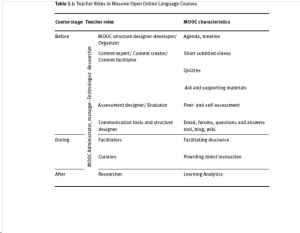From Maria Dolores Castrillo de Larreta-Azelain, “Chapter 5. Language Teaching in MOOCs: the Integral Role of the Instructor”. This chapter is also worth reading. Lots of very good advice.
Book available here: http://www.degruyter.com/viewbooktoc/product/455678
I like this in the introduction:
MOOCs appeared quite disruptively in 2011 as a new model of online education evolving naturally from the learning based on the social network.
And then some agreement about what is in a MOOC:
These courses consist of brief bites of videotaped content, automated correction assessment and feedback questionnaires, peer assessment tasks, and tools for communication and collaborative work, such as discussion forums, blogs and wikis
But what does the Instructor do? I remember doing e-moderation courses where we went through Salmon’s Five Step Model (2003) – and I agree that makes sense in those types of courses. But does that work on a MOOC? I agree with Castrillo that a new model is required.
So, the instructor has a much bigger role to play before the MOOC starts, and perhaps a smaller one during the running of the course?
Castrillo defines four ‘steps’ in the planning part of a MOOC:
1. Divide your course in meaningful units or modules, 1- or 2-week long. According to recent research, the optimal length of MOOCs lies between 6 and 12 weeks. Longer courses have lower engagement and completion rates.
2. Estimate the hours of study for each unit or module. It is preferable to overestimate the number of hours to avoid the feeling of frustration which an underestimate may cause to the student. The average of weekly hours of study in MOOCs lies between 4 and 8.
3. Set a mastery standard for each unit and, depending on that, discriminate among compulsory and optional learning targets by assigning explicitly distinct tasks. The student must be aware at all times of the compulsory or optional nature of each of the tasks.
4. Include a proposed timeline with the sequencing of contents. Past experience seems to advise making the different units or modules incrementally available, and keeping them open and accessible up to the end of the course. In this way, learning along the suggested scheduling is facilitated (‘guide on the side’) while flexibility is reinforced by allowing the student to enrol at a later time, to review
the contents, to delve into previous units, etc.
Our MOOC will be split into two, each of 4 weeks, so in total within the optimal length outlined above. Over-estimating the amount of hours needed (to avoid frustrating the student) is a good point. Also, having compulsory and optional activities is a good idea. And, allowing students to go back to earlier units also makes sense.
Re the short videos, I like this sentence:
The short videos resemble individualized tuition and allow students to control the delivery speed by stopping at certain passages, replaying others and reviewing contents.
And there needs to be:
a set of several questions and issues to be tackled by the student before, during and after
viewing the instructional videos.
Importance of both self and peer assessment.
Regarding peer assessment,
Some recent research suggests that the results of task revision by four peers would be just as appropriate as those provided by the revision conducted by a single instructor (Patchan, Charney, & Schunn, 2009 (pdf)).
Other points mentioned in the chapter – read it for more information – include:
Asynchronous and synchronous communication tools. Be care about the design – see How NOT to Design a MOOC: The Disaster at Coursera and How to Fix it, 2013.
Chaos in the forums – I am still unsure how to prevent this.
New professional roles within MOOCs: curator and facilitator.
